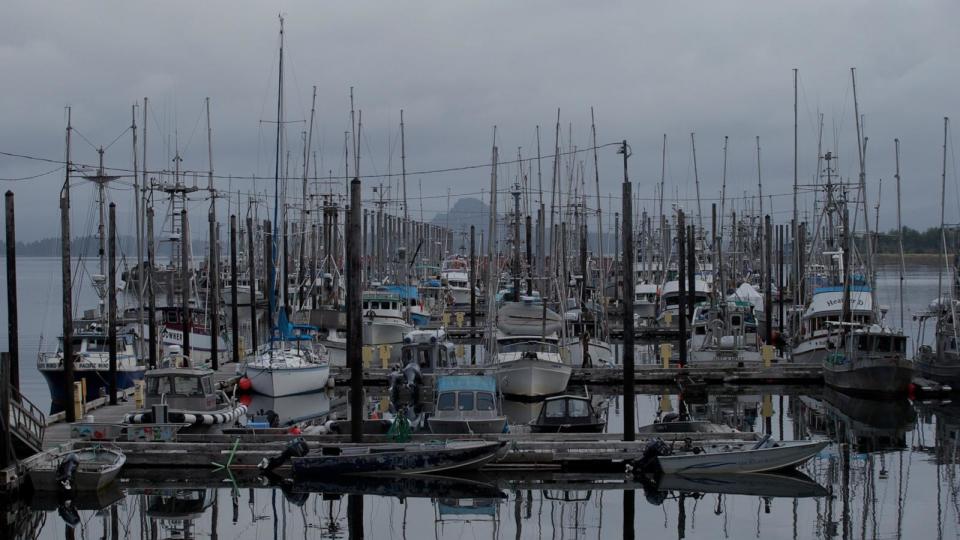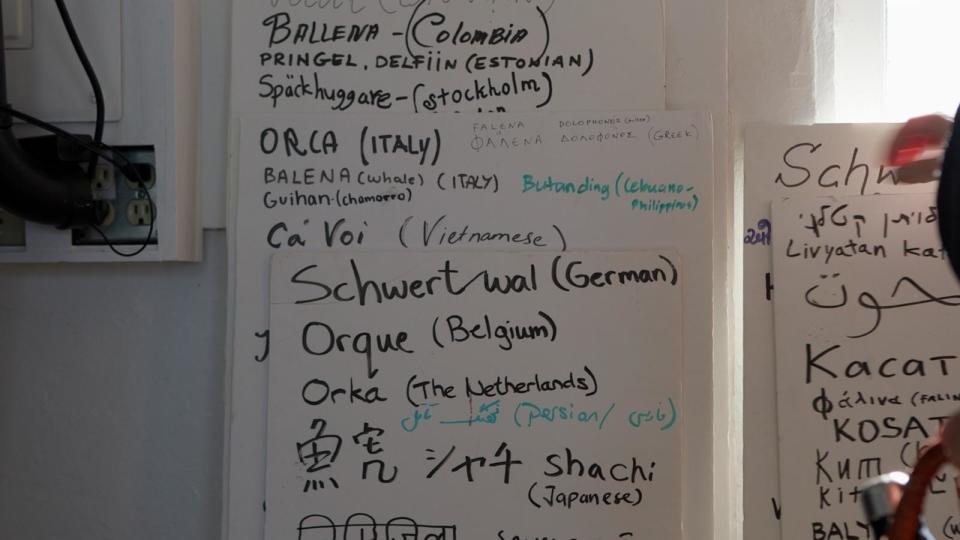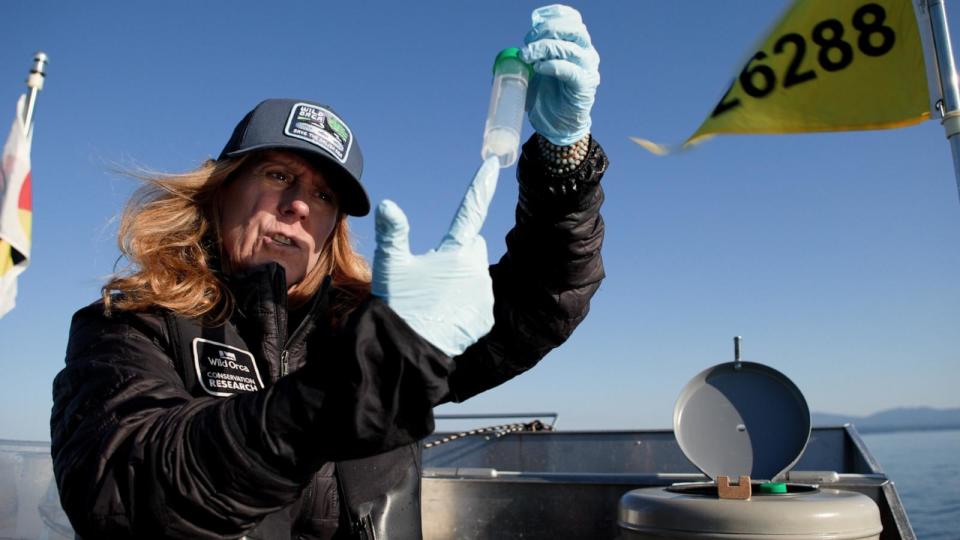King salmon populations are dying, simultaneously affecting orcas and local Alaskan communities

Tad Fujioka always had great problem-solving skills. After studying and working as an engineer, he left the field 14 years ago to become a troll fisherman based in Sitka, Alaska.
"If you’re good at solving problems in one environment, that translates directly to another environment,” he told ABC News, adding that there are other benefits to the job. “I love the freedom to follow my instincts, I don’t have to report to a boss, I love being out on the water in a beautiful country."
Today he’s the chairman of the Seafood Producers Cooperative in Sitka, Alaska, and supports his family by troll fishing on his 31-foot boat, the Sakura. One of the most important types of fish he reels in is king salmon -- the largest and most expensive species of salmon in the Pacific.
MORE: 'Fat is fit': Alaska's Katmai National Park gears up for annual Fat Bear Week
But now, Fujioka is facing a new problem. The fish, which are also known as Chinook, are vital to the state’s rural economy but are also the primary prey for a group of starving orcas in the Salish Sea known as the southern residents. It’s a recipe for disaster that has Southeast Alaska’s troll fishery caught at the heart of a legal showdown that could potentially stop the king salmon harvest in an effort to help the endangered killer whales.
The case is still working its way through the courts, and has left the small communities on both sides of the issue waiting on a result that will impact their culture, economy and way of life.
"To lose access to the king salmon resource would have turned a marginally poor season into a disastrous season,” said Fujioka, who estimates that these fish accounted for two thirds of his income. “It has a direct effect on rural southeast Alaska."
In 2019 the federal government acknowledged that Southeast Alaska’s limits for king salmon troll fishing didn’t allow for enough fish to migrate south to southern resident territory.
A year later, the Wild Fish Conservancy, a conservation group in Washington State, filed a lawsuit against the government alleging that it had violated environmental law by continuing to allow the king salmon troll fishery to operate. The government did have a plan to introduce hatchery fish to mitigate the damage, but had not proven that it would be successful and leave enough for the whales.
"If we keep doing what we're doing, these populations will eventually not exist, and these whales may not exist," Emma Helverson, executive director of the Wild Fish Conservancy, told ABC News.

In May 2023 a judge ruled in the WFC’s favor, and granted its request to close the fishery while the government determines if a harvest can continue without harming the orcas. But a circuit court panel later reversed this decision, citing a potentially “disastrous” economic impact, after hearing from the Alaska Trollers Association and other parties.
"There’s this perception that Alaska is catching all of their fish -- we are viewed as ‘big, bad Alaska,'" said Dani Evenson, of the Alaska Department of Fish and Game. "We all share the responsibility of conservation, but people like to point fingers. Everybody wants a silver bullet."
King salmon is vital to small communities in Alaska
King salmon trolling, which is a style of fishing involving small boats and individual fishing lines dragged through the water, has an estimated economic impact of $85 million in Southeast Alaska. In 2022, king salmon caught in Southeast Alaska were valued at just over $16 million, according to data from the Alaska Department of Fish and Game.
In cities like Craig, which has just over 1,000 residents, many families rely on the fishing industry — even the mayor is a commercial troller. He told ABC News the city’s population could decrease by half if king salmon fishing were halted indefinitely. He was also keen to counteract campaigns for consumers to stop eating the fish.
"You’re going to break a bunch of fishermen. You’re going to destroy some communities in Alaska. You’re going to put a bunch of kids out of work or out of school," he said. "Is that what you want to do by not eating king salmon?"
Julie Yates, who lives in Craig, worked alongside her father on his troll boat for years before becoming a commercial fisherman.
"It’s been the dream to follow in his footsteps and continue this," said Yates, who has also been teaching her son Bear about the family business and is concerned about the uncertainty the lawsuit has brought.
"It’s hard to even think about what the future looks like," she said.
The salmon also serves as a food source for locals, which is especially valuable as grocery prices continue to increase. A 2023 report named Alaska the fifth most expensive state in the U.S. in terms of cost of living.

Members of the Tlingit & Haida Indian Tribes of Alaska, for whom king salmon is a traditional food, have also weighed in on the lawsuit, filing an Amicus brief in October last year.
"Salmon -- a foundational food source for Southeast Alaska Indigenous communities—are particularly revered. Trolling for Chinook salmon is a traditional, respectful, and sustainable method of harvesting this culturally significant food,” the brief reads, adding that the groups "do not support blunt measures that place the heaviest burdens on the Indigenous people who depend on the Chinook troll industry for both their individual and community wellbeing."
Clinton Cook Sr., President of the Craig Tribal Association, who was involved in filing the brief, said it’s a common misconception that people in Alaska prioritize industry over the environment.
"That’s about as wrong as it gets," he said. "We’re the indigenous people of the southeast, we’ve been here for generations. We’re stewards of the land and the water -- that’s been our history for thousands of years."
"We’ve always protected our environment, our fish are sacred to us," he added. "When people try to take that away, it’s not ok."
Fates of chinook salmon and orca whales are intertwined
Decades ago Chinook were able to survive in the wild for more than nine years, which allowed them to grow to larger than 100 pounds. Today, the average size of Chinook in Washington State is between 10 and 15 pounds, and their population is decreasing. The total amount being caught or returning to rivers in the Salish Sea has fallen from just over 800,000 in the 1980s to just over 400,000 in 2018, according to data from the Pacific Salmon Commission. Two types of Chinook are listed as threatened under the Endangered Species Act.

This is a problem for the ocean’s ecosystem as a whole, but specifically for the southern resident killer whales, officials said. A group of 74 whales made up of three pods whose territory usually extends from Haida Gwaii in British Columbia, Canada, to Point Sur, California. They have been dubbed "icons of the West coast."
The whales evolved over hundreds of years to feed specifically on Chinook salmon. After losing a large amount of their population to marine parks in the 1970s and 1980s, and were listed as endangered, and seven are listed as threatened under the Endangered Species Act. Today they face a multitude of challenges including high levels of toxins in their water and increased noise from boat traffic -- both of which are exacerbated by the fact that their primary prey is rapidly declining.

Biologists estimate that 69% of pregnancies among the southern residents fail, largely due to a lack of food.
"They are basically in a constant state of hunger the southern residents go and there's one fish that they’re trying to share between three or four family members," said Deborah Giles, science and research director of Wild Orca, who has spent decades studying the whales. "Just in one whale’s lifetime, we have completely changed their ability to survive."
Whale watching communities need healthy salmon population
Meanwhile, 640 miles southeast, the livelihood of another small island community depends on the ocean as well -- but in a different way. Friday Harbor, Washington, is a town of about 2,500 people in the picturesque San Juan islands, where whale watching represents 13% of total employment in the region and brings in half a million visitors every year, officials said.
"It’s one of the peak life experiences to see whales in the wild, especially out here," said Jeff Friedman, a marine naturalist and owner of a whale watching company based in Friday Harbor, noting the island has people coming from as far away as Australia and Europe to see the southern residents and other groups of whales. "Obviously our businesses are dependent on that, as well as the hotels and restaurants and other island businesses that people support when they’re out here."
These whales are particularly beloved among tourists and residents.
"The southern residents are probably the best known population here,” Amy Nesler, Communications and Stewardship Manager at the San Juan Islands Visitors Bureau, told ABC News. “We end up with newspaper articles every time they have a new calf, or we’ll have a memorial of the ones we lose in a year."
They used to be a common site on whale watching tours, but have become much more rare in recent years.
"We don’t see them in the inland waters like we used to, because they don’t have salmon," Friedman said, noting that he and other operators follow a strict set of guidelines prohibiting boats from getting too close to the group to prevent damage from boat noise.
"We have impacted their world," he said. "I think it gives us not just a sense of responsibility, but a desire to do something right for them and make sure they have the environment to thrive."
King salmon populations are dying, simultaneously affecting orcas and local Alaskan communities originally appeared on abcnews.go.com

